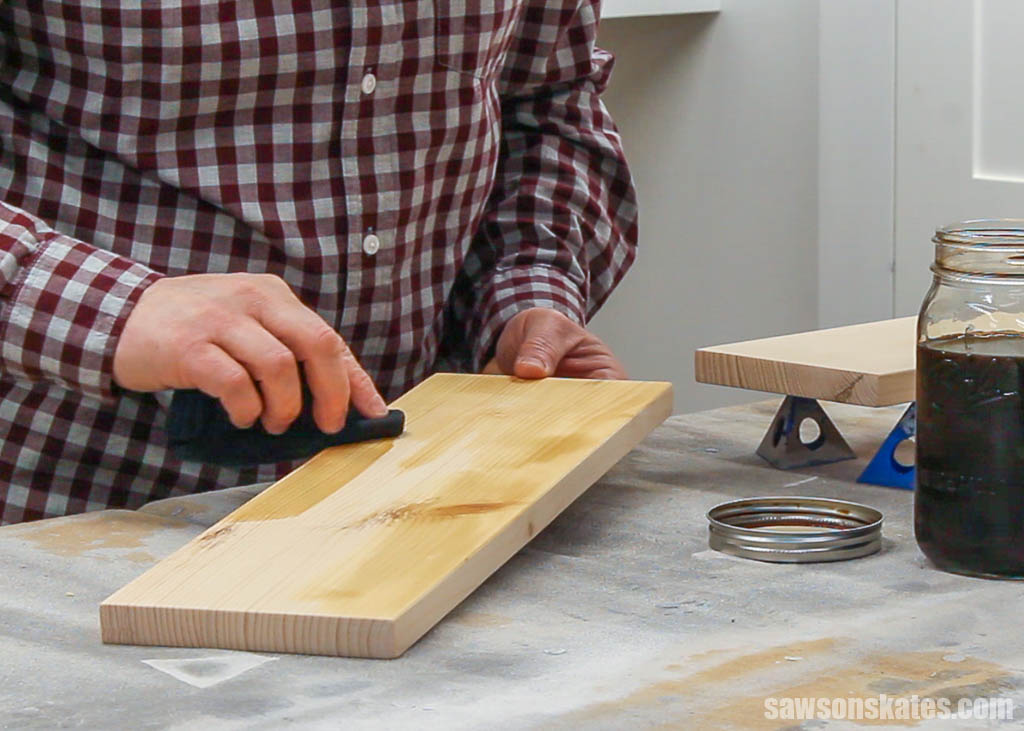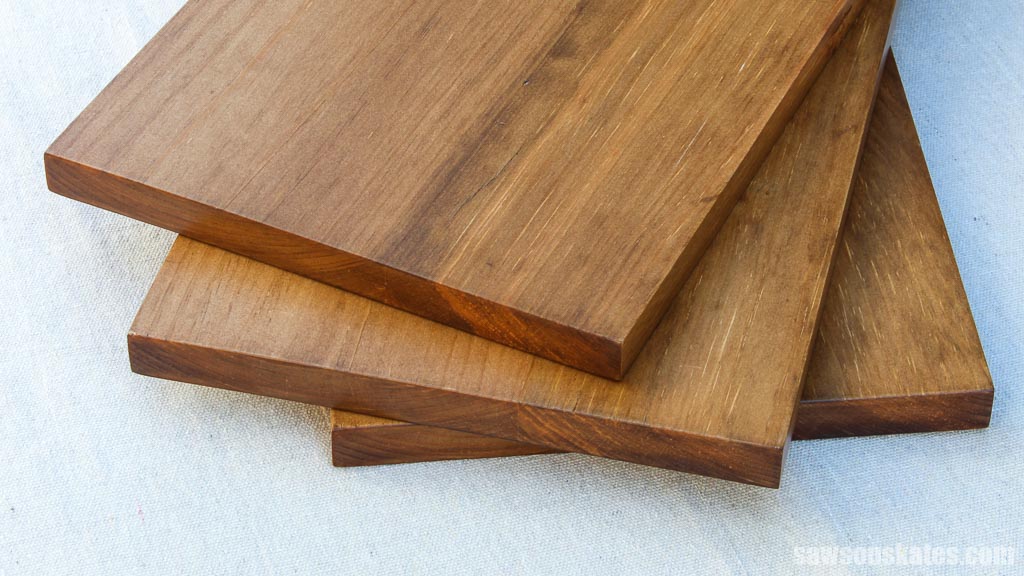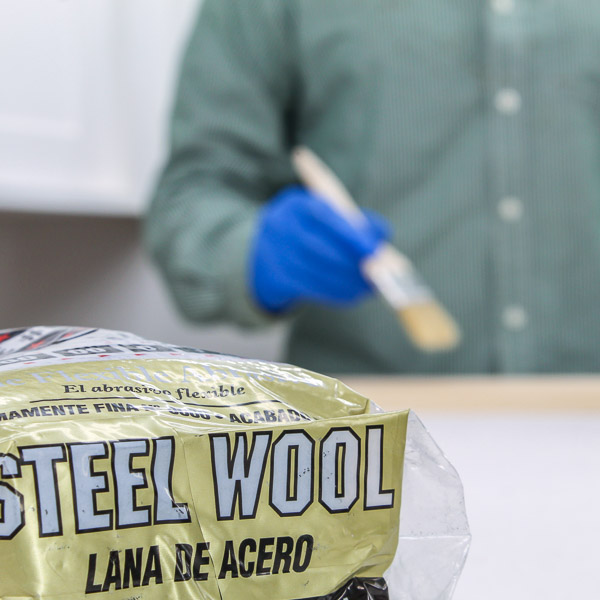Natural Wood Stains (Recipes + Tips for Beautiful Results)
Transform your woodworking projects with natural wood stains! Learn how to make eco-friendly stains and the pros and cons of using natural ingredients.

Natural wood stains are an excellent option if you’re looking for an environmentally friendly way to stain your wood projects. Unlike traditional oil-based stains, natural wood stains are made from fruits, vegetables, and nuts.
Not only are homemade wood stains better for the environment, but they can also provide stunning results. So get ready to enhance the beauty of wood with some supplies you probably have in your kitchen!
Table of Contents
- What is Natural Wood Stain?
- Natural Wood Stains: Pros and Cons to Consider
- Types of Natural Wood Stains
This article contains affiliate links. If you purchase from these links, I may earn a small commission at no additional cost to you. Visit my site policies for more information.
What is Natural Wood Stain?
A natural wood stain uses ingredients like fruits, vegetables, and nuts to color wood.
Homemade wood stains are easy to make and can provide beautiful results. Plus, they’re better for the environment than traditional oil-based stains.
Natural Ingredients
Natural wood stains are often made with food-grade items such as turmeric, tea, beets, vinegar, coffee, raspberries, cabbage, avocado, and more.
Environmentally Friendly
Natural stains are simple to apply, easy to clean up, and most may be disposed of in the same way as an unfinished cup of coffee.
Nonflammable
Natural stains are also nonflammable, making them a safer option to use around your home.
Blotchy
Some wood species, like pine, have unevenly dense grain, which makes it difficult to stain.
Think of these difficult-to-stain woods like a kitchen sponge. However, this sponge is unique because some areas are denser than others.
The stain applied to this sponge stays closer to the surface in the denser areas while more stain soaks into the less dense areas. As a result, the color becomes patchy and uneven, with some spots staining lighter while others are darker.
Oil-based stains, in particular, often have a patchy appearance. On the other hand, homemade stains seldom have a blotchy appearance like store-bought stains.
Natural Wood Stain vs Oil-Based Stain
Natural wood stains are made of natural ingredients, are environmentally friendly, and can be cleaned up with water. They’re nonflammable and don’t produce smelly fumes, so they’re generally safe to use in the house.
Oil-based wood stains are made from petroleum products, contain harmful chemicals, and have unpleasant odors. They require mineral spirits or paint thinner for cleanup and are combustible, so they should only be used in a well-ventilated area.
Drawbacks
There are several advantages to using natural stain, but it also has drawbacks.
First, these DIY stains don’t usually produce as deep a color as a store-bought oil-based stain. One exception is the steel wool and vinegar stain, which can produce a dark, rich stain.
Second, homemade wood stains can raise the wood grain, so you’ll need to lightly sand the surface before applying a top coat.
Third, because DIY stains aren’t as fade-resistant in direct sunlight as oil-based stains, they may become lighter over time.
Finally, water will remove the stain from the wood. As a result, I don’t suggest applying a water-based top coat directly on the stain because the finish may remove some of the color.
If you can’t apply a water-based finish directly to the stain, you’ll need to apply an oil-based top coat like polyurethane or seal the stain with a shellac-based sanding sealer before applying a water-based finish such as Polycrylic.
Related: Polyurethane vs Polycyrlic: Are They The Same?
Natural Wood Stains: Pros and Cons to Consider
Pros
- Made with environmentally friendly ingredients
- Easy to apply
- Water cleanup
- Nonflammable
- Generally safe to use in the house
Cons
- May fade in direct sunlight
- Colors may not be as deep as oil-based stains
- Water-based top coats may remove some of the color
Types of Natural Wood Stain
Now that we’ve answered, “what is natural wood stain?” let’s move on to the recipes!
You can apply natural wood stains on almost any kind of wood, including pine, oak, cedar, ash, hickory, and so on. For all of the samples in this article, I applied the stains on pine.
💡 TIP: Each wood stains differently. It’s a good idea to test the stain on a of piece of scrap wood before applying it on your project. Testing will allow you to be confident that the stain will produce the desired result.
Here are a few DIY wood stains that you can make at home:
- Coffee Wood Stain
- Steel Wool and Vinegar Stain
- Tea Wood Stain
- Black Walnut Wood Stain
Natural Wood Stain Made With Coffee
Ingredients
You only need two simple items from your kitchen to make coffee wood stain: coffee and water. You’ll also need something to brew the coffee, such as an electric coffee maker, stove top percolator, or pour-over coffee dripper.

Color
On pine, coffee stain produces a warm, caramel-like color which reminds me of a store-bought “Golden Oak” stain.

Where to Use
You can use this stain on a variety of projects. I used it on the shelves for this DIY cupcake stand.
Related: How to Make a Folding DIY Cupcake Stand

Get the Recipe
Get the coffee wood stain recipe here, including helpful tips and tricks such as which coffee I used and how many coats to apply.
Natural Wood Stain Made With Steel Wool and Vinegar
Ingredients
This natural stain is made with two simple items: steel wool pads and vinegar.
In this tutorial, I tested a variety of vinegar types, such as white, apple cider, red wine, and balsamic, but I found white and balsamic produced the most dramatic results.

Color
Steel wool and vinegar stain produced the deepest, richest color among the homemade stains on this list.
You may use this natural stain on raw wood, or you may first apply a homemade wood conditioner which will enhance the color of the stain even more.
Balsamic vinegar produces colors with a cool, greenish undertone.
White vinegar, apple cider vinegar, and red wine vinegar produce colors with a reddish undertone that range from reddish-brown to a warm, medium brown.

Where to Use
Based on my tests, I believe the color of wood stained with steel wood and vinegar was closest to a store-bought wood stain. So I would use this mixture when you want a dark wood stain for your DIY or furniture project.
Get the Recipe
Get the steel wool and vinegar stain recipe here, including helpful tips and tricks such as the shelf life and safety notes about the chemical reaction.
Natural Wood Stain Made With Tea
Ingredients
To make tea wood stain, you need two easy-to-find items: tea bags and water.
Color
Tea stain produced the least amount of color among the natural wood stains on this list. It adds to the yellow tone and gives a somewhat aged appearance on pine.

Where to Use
I think this natural stain works best for giving wood an aged appearance; however, I use it the most as a pre-stain conditioner for other stains.
Get the Recipe
Get the recipe for the tea wood stain here, including helpful tips.
Natural Wood Stain Made With Black Walnuts
Ingredients
Like coffee and tea stains, you only need two simple items to make black walnut wood stain: black walnuts and water. You have the option of making it with black walnuts from your yard or buying store-bought walnut hull powder.
⚠️ ALLERGY WARNING: This natural stain contains tree nuts.

Color
The black walnut stain produces a warm, caramel-like color that resembles coffee wood stain with just a few coats. The color becomes light, medium brown with a reddish undertone with additional coats.

Where to Use
You can use this stain on a variety of projects. I used it on the treads for these DIY dog stairs.
Related: How to Make DIY Dog Stairs

Get the Recipe
Get the black walnut wood stain recipe here, including helpful tips and tricks such as how to give it a longer shelf life and where I bought the walnut hull powder.
Final Thoughts
If you’re looking for an environmentally friendly way to stain your wood projects, natural wood stains are worth considering.
Unlike traditional oil-based stains, which can be harmful to the environment, many DIY wood stains are made from all-natural items like fruits, vegetables, and nuts.
Not only are they better for the environment, but they can also provide stunning results.
Are you ready to add color to wood with some simple items you probably already have in your kitchen?
Thank you for stopping by. If you enjoyed this tutorial, would you please take a moment and pin it to Pinterest? I’d really appreciate it!




